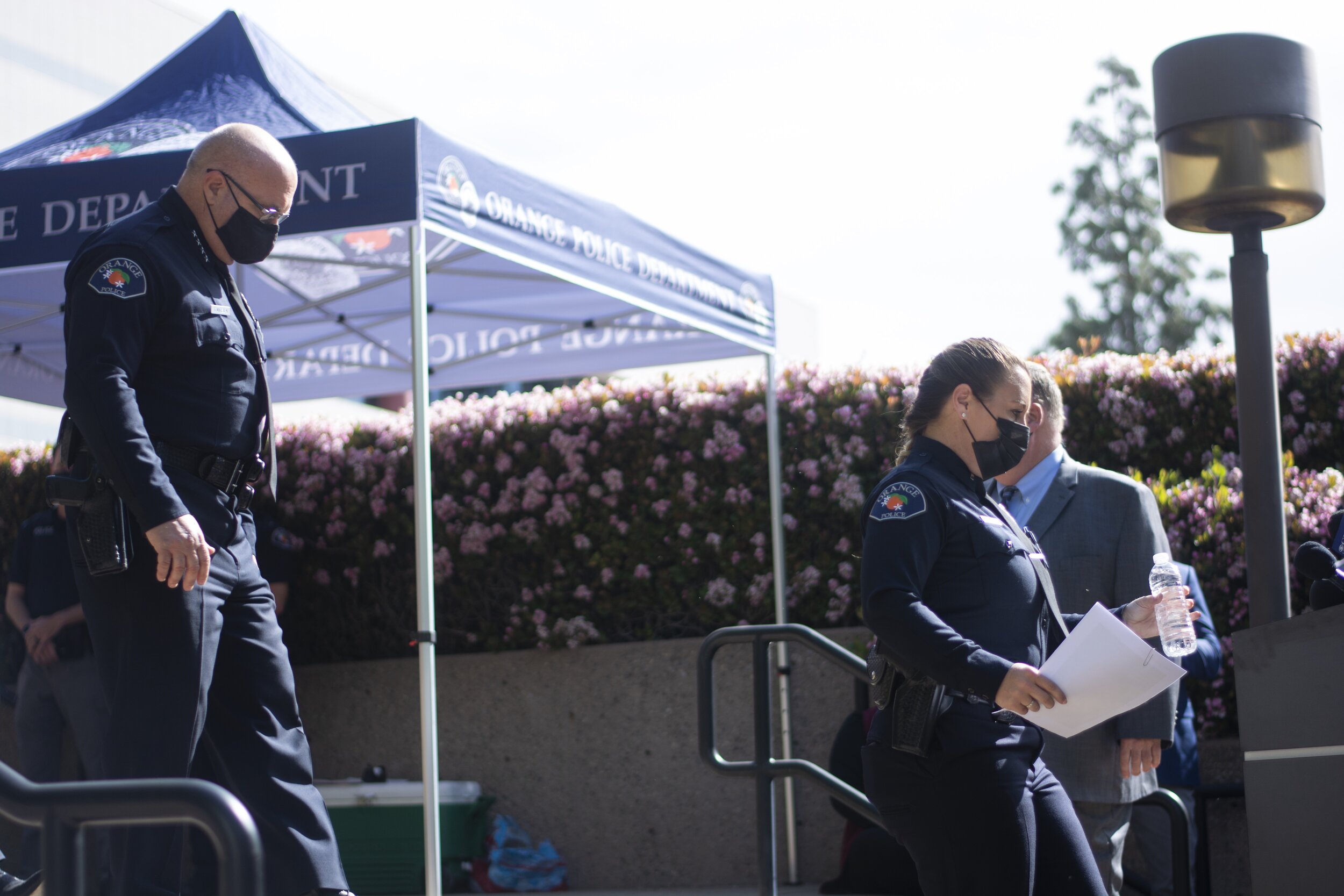Orange Police Department withholds evidence of Orange shooting
Orange County District Attorney Todd Spitzer asked the Orange Police Department (OPD) to withhold evidence from the March 31 Orange shooting indefinitely, because the evidence of the Orange shooting could have a negative effect on the investigation. Above, OPD Chief Tom Kisela (left) and Lieutenant Jennifer Amat (right) prepare to deliver a press conference after the shooting April 1. SAM ANDRUS, Photo Editor
Just one month after a shooting in Orange left four dead — one of the deadliest shootings in Orange County history — Orange County District Attorney Todd Spitzer urged the Orange Police Department (OPD) to not release 911 calls and police-worn body camera footage because it could negatively affect criminal investigations. including murder and a police-involved shooting.
OPD Lieutenant Jennifer Amat announced the news at an April 21 press conference, where reporters were waiting for the release of the evidence.
“Moments ago, the Orange County District Attorney Todd Spitzer notified our chief that the release of this video may impact the successful criminal prosecution of the case,” Amat said. “The Orange County District Attorney’s Office has been a part of the ongoing investigation and had previously viewed the video we intended to release. As you know, justice for the victims and their families is our top priority.”
In his April 21 letter to Orange Police Chief Tom Kisela, Spitzer explained that the evidence — which contains portions of two 911 calls, body-worn camera footage and details of items found in suspect Aminadab Gaxiola Gonzalez’s possession — could negatively impact the prosecution and decisions made in the case.
According to California law, agencies are required to release recorded evidence within 45 days of reasonably knowing about the incident, with the only exception being the potential compromise of an investigation.
“While new laws require your department to release videos after the incident occurs, there are exceptions when there is an on-going criminal prosecution,” Spitzer wrote to Kisela. “I am respectfully asking you to not release any more information about this case at this time.”
Jeff Compangano, an attorney and Chapman University professor who teaches communication law, emphasized a conflict between the First Amendment right to media coverage and the Sixth Amendment right to a fair trial.
“It could show something that’s not fully admissible in trial,” Compangano said. “Especially since a child was shot, the district attorney would want to hold all that back until they at least get the case going and evaluate it. It’s generally something that’s going to generate a lot of emotion around it.”
Additionally, since the case includes a police-involved shooting, Compangano explained that it’s commonplace for these details to be delayed so more information can be gathered.
“I’m not really surprised,” Compangano said. “It seemed way too quick for it to come out anyway. The District Attorney (Office) wants to build their case first before the public starts getting in an uproar and the press gets involved … The video shows a perspective, but it’s hard to tell everything from the videos.”
Chapman law professor Larry Rosenthal also explained withholding evidence could be beneficial for the case itself.
“For example, sometimes an agency wants to keep the details of how a crime was conducted secret,” Rosenthal said. “(This would) minimize the risk that individuals seeking to cut some sort of deal for themselves will offer false information about the crime in order to gain favorable treatment.”
Spitzer also explained that many facts and details of the investigation are still unknown and ongoing, emphasizing the need to delay releasing evidence. Gonzalez has been charged with four counts of special circumstances murder, one count of attempted murder and two counts of attempted murder of a police officer. His arraignment has been postponed because he cannot communicate with his court-appointed attorneys in his hospitalized state.
“The investigation into this quadruple murder and into the defendant’s background is ongoing,” Spitzer wrote. “Moreover, I have yet to decide on whether or not to seek the death penalty in this case.”
The Orange City Council voted to require officers to wear body cameras last year, and the changes have only been in effect since the end of 2020.
It is unclear when the police department will release the evidence, but it will likely be only after further investigation is conducted and the Orange County District Attorney’s Office deems it acceptable.

